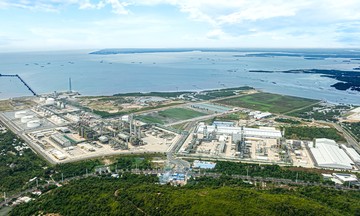In the fast-food world, McDonald’s is a familiar name, a symbol of resilience and innovation.
With over 43,000 restaurants in more than 100 countries, the "Golden Arches" brand (derived from McDonald’s iconic logo, with two golden arches forming the letter "M") has weathered severe economic storms, from post-Covid-19 inflation to tariff pressures and changing consumer habits.
What is the secret to McDonald's not only surviving but thriving in the challenging landscape of 2025?
According to the Economist, it’s the perfect combination of a reliable menu, reasonable prices, and smart marketing strategies, creating a unique formula for success. Since going public in 1965, McDonald's has performed best whenever it has stuck to this original strategic blueprint.
 |
Outside a McDonald's restaurant in London, England. Photo: Reuters |
Outside a McDonald's restaurant in London, England. Photo: Reuters
Consistency in flavor is the fundamental basis upon which McDonald's has built customer loyalty. Whether in New York (USA) or Tokyo (Japan), a Big Mac always delivers a familiar experience, like "a promise that never changes". However, lessons from the past, during the period of 1999-2003, when excessive branch expansion caused the company to lose two-thirds of its market value, taught them a valuable lesson: to focus on "core menu items" like the Big Mac, french fries, and chicken nuggets.
2025 witnessed the strong return of this strategy by the "Golden Arches", with the "Minecraft Meal" campaign in March and April. The partnership with the blockbuster movie to create a collecting craze helped the fast-food chain’s sales skyrocket in just two weeks, according to Bloomberg. A food safety incident in October 2024 across 14 US states threatened their reputation, but the company's swift response in close coordination with health authorities reinforced customer trust, according to Reuters.
Post-Covid-19 inflation has caused McDonald's prices in the US to increase by 40% from 2019 to 2025, sparking discontent as a Big Mac combo reached 18 USD. Notably, the low-income customer group, their core demographic, began to visit less frequently.
In response, McDonald's launched the "McValue" menu in July 2024, with a "5 USD meal" featuring a burger, fries, chicken nuggets, and a soft drink, along with a "buy one, get one for 1 USD" offer through their digital app.
The affordable pricing strategy helped McDonald's global revenue increase by 3.8% and US revenue by 2.5% in Quarter II, ending four previous quarters of stagnation. However, inconsistent pricing—a Big Mac costs 4.36 USD in Austin but 7.06 USD in Seattle—reveals the challenge of balancing affordability and profit.
Creative marketing is McDonald's weapon for maintaining its appeal. This year, collaborating with Hollywood superstar John Cena to promote the McValue menu created a strong connection with both young customers and families, according to Adage. The "Minecraft Meal" campaign also resonated with Gen Z, capitalizing on pop culture trends. After less effective campaigns in 2024, McDonald's has learned how to create attention-grabbing promotions and reinforce its brand image as delicious food, high value, and a memorable experience.
The franchise model is also a crucial "economic shield" for McDonald's. With 95% of its 13,500 US restaurants and a similar percentage globally operated by franchisees, the company profits from licensing fees and rent based on sales, achieving an impressive 47% profit margin in Quarter II. As tariffs increase the cost of ingredients like Brazilian beef and Colombian coffee, this model shifts much of the risk to franchisees, leaving McDonald's less vulnerable than competitors like Chipotle or Shake Shack.
Furthermore, the ability to optimize costs and management processes thanks to the tools and analytical data provided by McDonald’s helps franchise owners improve profit margins and recoup their investments faster. This makes owning a McDonald’s restaurant a sustainable and highly profitable investment.
In addition, 60% of revenue from international markets allows the company to benefit from a weak USD, providing a competitive advantage over less globalized chains like Yum! Brands or Chipotle.
However, the company also faces significant challenges. While the McValue menu attracts low-income customers, this group is shifting towards buying groceries instead of eating out, while wealthier customers are opting for higher-end restaurants like Chili’s, according to the Financial Times.
At the same time, low-price pressure can reduce franchisee profits, especially with rising ingredient costs. Without timely support, the company risks facing dissatisfaction from its franchise partners, impacting service quality.
In an uncertain economic climate, McDonald's remains a symbol of resilience, but its future depends on its ability to adapt to the ever-changing market. To continue its success and growth, according to expert Schumpeter from the Economist, McDonald's needs constant innovation to retain customers and maintain harmonious relationships with its franchisees.
Phong Lam (According to the Economist, WSJ, Bloomberg, Adage)












